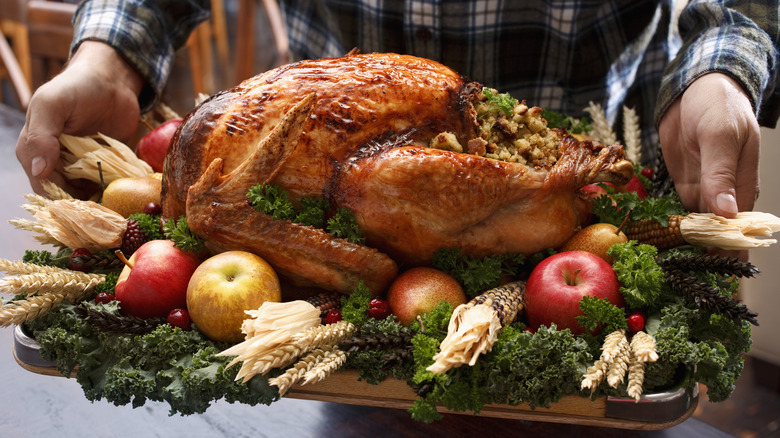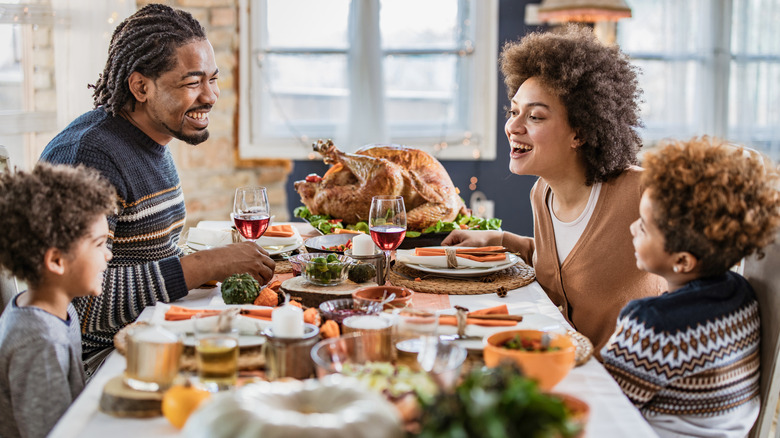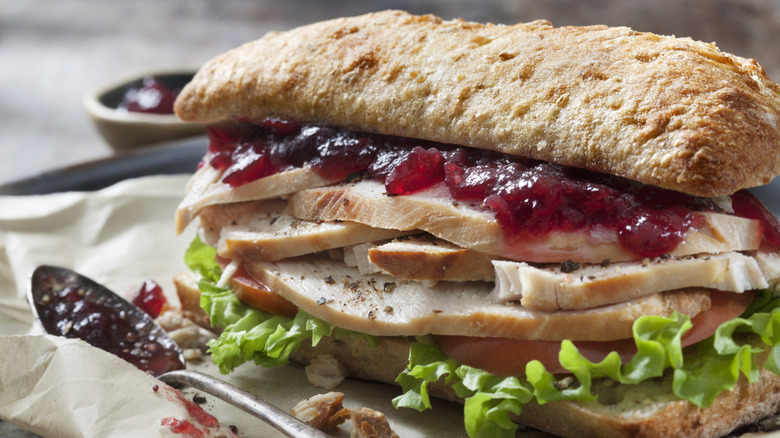The Reason Turkey Is Our Go-To Bird On Thanksgiving
We may receive a commission on purchases made from links.
Turkey has long been associated with autumn and winter holidays in America, starting with traditional Thanksgiving gatherings in November. It's the crowning glory of a holiday meal, often presented with fanfare and a ceremonial carving at the head of the table. The big bird reigns as culinary king, so engrained in time-honored Thanksgiving customs that it's hard to imagine the holiday without its presence. This is largely due to ease of access to the bird, but also artistic endeavors by novelists to commemorate turkey's place on holiday tables.
Tracing the turkey's rise in glory can be complicated, but it essentially comes down to practicality. By some estimates, 10 million-plus gobblers roamed American soil by the time European settlers arrived, making them plentiful and accessible. Larger than other types of fowl such as ducks and geese, they were perfect for group gatherings, including what eventually became known as Thanksgiving. Family farmers had ample access to the animals, which, unlike chicken and cattle, weren't needed for supplying year-round sustenance such as eggs, milk, and butter.
Venison supplied by Native American deer hunters was more likely the meat consumed at the Pilgrims's first autumn feast in 1621, now dubbed the first Thanksgiving. It took 242 years for that feast to become an official national holiday, established by President Abraham Lincoln in 1863. Turkey had by then claimed its spot as the star of the show, but it took more than practicality to get there.
Thanksgiving turkey in literature and politics
Turkey becoming the star of Thanksgiving was a gradual evolution, aided by renowned politicians and cultural impact from literary figures. Founding Father Alexander Hamilton, now considered the world's coolest politician due to the Broadway show featuring his life, seemed to have been a fan of the big bird. He is widely (perhaps apocryphally) credited with declaring that no citizen of the United States shall refrain from eating turkey on Thanksgiving Day. Never mind that his family's holiday table in the 1700s likely included other era delicacies such as hog's ears and stewed eel.
Turkey lore rose in the 1800s, with renowned writers cementing the place of turkey in holiday meals, including Thanksgiving. Novelists painted literary scenes featuring tables laden with the earth's bounty, crowned by a whole roasted turkey and gravy. Author Sarah Josepha Hale, a fervent proponent of Thanksgiving as a unifying national holiday, placed the turkey as a centerpiece of the Thanksgiving menu in her 1827 novel titled "Northwood, A Tale of New England." Less than 20 years later, Charles Dickens did the same for the Christmas holiday, giving the turkey a crucial role in his nostalgic tale of "A Christmas Carol."
Why we still love Thanksgiving turkey today
The past aside, there's still an enduring devotion to turkey on Thanksgiving all these years later. It could be nostalgia, a yearning for national identity, or a belief that common customs and foods serve as a unifier within families and countries. In fact, historians now believe that author Sarah Josepha Hale viewed Thanksgiving as a way to unify Americans in the 1800s as they veered toward the Civil War — and that it was her letter to Lincoln that finally made him nationalize the holiday.
Turkey also happens to be delicious and nutritious, an excellent source of high-quality protein — which is great for muscle development and maintenance (per Healthline). It harbors a wealth of B vitamins and minerals such as phosphorus, zinc, and selenium. Regardless of how turkey is cooked – whether roasted, brined, grilled, air-fried, or smoked — eating turkey fresh from the oven on Thanksgiving Day is one of the most delicious and nutrtitious ways to consume the famous bird.
And one of the best parts about turkey on holidays is the next-day fresh turkey soups and sandwiches, spread with crimson cranberry sauce or heaped with warm leftover gravy. After all, half the fun of Thanksgiving is the creative ways to use those leftovers.



